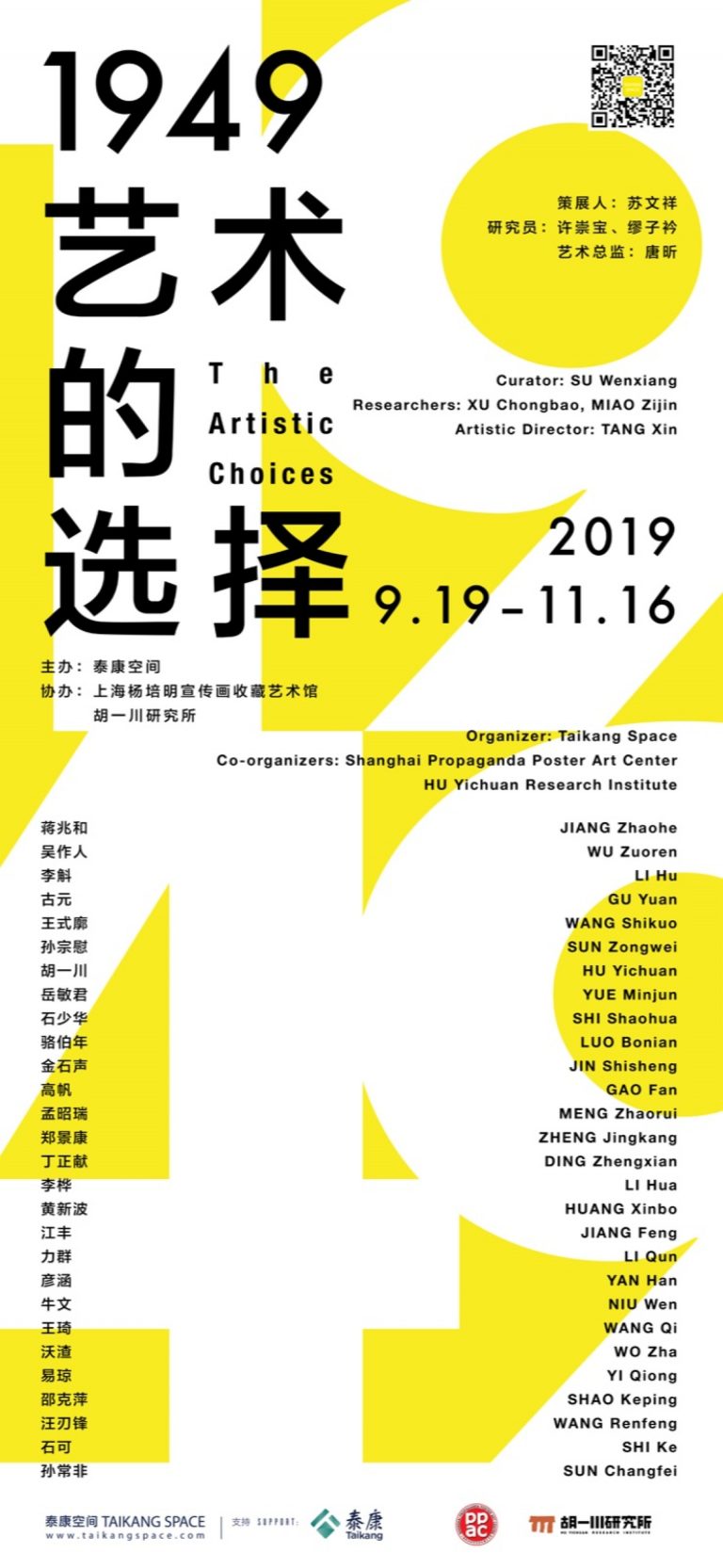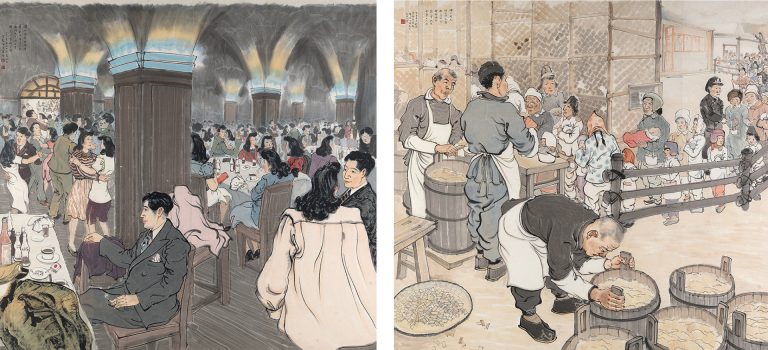
As a critical moment in history, 1949, no matter what choice has been made, has brought a brand new experience for both old and new. On March 5th, the Communist Party of China announced on the report of the Second Plenary Session of the Seventh Congress that its focus of future would be moved from rural to urban areas. How would they then conduct city management? How would the old habitants who live in the city deal with the new regime and the new ideology? Would they passively accept transformation, or actively reinvent themselves? Not only were they confronting the propositions proposed by the new era, but more urgently, they had to choose and answer questions themselves.
Through the lens of period history, the exhibition “1949: The Artistic Choices” is planned to arrange and expand discussions from multiple units like “Preparation”, “Foundation”, and “Celebration”. Presenting typical artworks and images created in 1949 – the special decisive moment, the exhibition attempts to link the political and artistic events happening in this year, illustrating a twofold scene situating in the intersection of art and politics in this particular complex moment.
At the end of 1948, the People’s Liberation Army besieged the city of Beiping. Should the fire be continued or ceased? The fate of Beiping was temporarily suspended.
On January 4th, 1949, the fourth day of the New Year, at the cadre meeting in Liangxiang, “There is no obstacle to conquest Beiping and Tianjin,” said Ye Jianying. Nevertheless, history has helped Fu Zuoyi make the right choice: Beijing announced its peaceful liberation. The cultural heritage of the city and the household of 2 million citizens have been properly preserved. On January 31st, 1949, the third day in the ji-chou year, the People’s Liberation Army took over Beiping.
A month before the transition, the party and the army have prepared for the takeover. The military control committee was established in Liangxiang, on the purpose to receive all the inheritance from the enemy. The organization also includes the cultural takeover committee consisting of Qian Junrui and Sha Kefu as the director and the deputy director respectively, as well as 17 members including Ai Qing. They were then asked to be “elegant and polite”, treating the old people with caution and respect, so that they could gradually serve the people. Since 1942, the cultural and artistic practice in Yan’an of the Border Region has already been incorporated into the “revolutionary machine” operating in high-speed. After entering the city, it has become an urgent task for the new rulers to continue to incorporate the old people and “transform them appropriately”. On February 10th, Wang Zhaowen, who was temporarily notified to take over the art school in Beiping, has already apparently invested in his new job. He must have participated in discussions with the old artists. In those days, he realized that “learning politics” was the big picture. Accepting the transformation was not less than a struggle within emotion and soul.

Sun Zongwei | Poor and Rich | 1948 | Ink and color on paper |150x162cmx2
During this year, Wu Zuoren, Jiang Zhaohe, and Xu Beihong all painted their important transformational works. It is undeniable that, from the perspective of the expansion of the subject matter, the new demands for serving the people and the public provide a new creative orientation for the old artists who have long lived in the Kuotong area. Previous “art for art’s sake” practice, such as Dong Biwu’s “beyond-class” artistic creation in the first National Congress of Chinese Writers and Artist, has finally landed to the ground. Compared with the artists from the liberated areas, the artists may not grasp the main points overnight, yet their art has begun to be down to earth.
The first National Committee of the Chinese People’s Political Consultative Conference held on September 21st gave proper design and planning to the national guiding principles and political system for the New China. The name of ‘Beiping’ was also changed to ‘Beijing’ on September 27th, which is the most important arrangement for the new regime. The delegation that sent to participate in the World Peace Congress in April can be seen as the first time that New China has raised its voice in the international scene.
The order of the literary and art circles has also been renewed. The most significant event is the first National Congress of Chinese Writers and Artist held from the beginning to the middle of July. The party gathered together the peers who had long been separated by the war. On the morning of July 6, Mao Zedong personally attended the conference and said, “As long as the people need you, we have reason to welcome you.” During the conference, “The First National Art Exhibition” organized by the Congress was held at the National Art School in Beiping. Various professional associations, including the China Artists Association, were subsequently established. The initial top-down design and management of the literary and art circles were completed.
As a celebration, the Xiyuan Airport military parade serves as the foundation stone for the Chinese Communists’ settlement in Beijing, which can also be regarded as an important prelude of the proclamation of the People’s Republic of China. Ten days after the opening of the Second Plenary Session of the Seventh Central Committee, the Central Committee of the Communist Party of China entered Beiping. On March 25th, at 4 pm, Mao Zedong and other leaders arrived at Xiyuan Airport and met with the democrats who had been waiting for a long time, and began the parade inspection at 5 o’clock. At the end of the ceremony, Xinhua News Agency broadcasted to the whole nation and the world: the Central Committee of the Communist Party of China, the Headquarters of People’s Liberation Army and Mao Zedong have successfully arrived in Beiping. In fact, on February 3, before the parade, “the People’s Liberation Army entered Beiping with the great hope of the people in the whole city”. A grand ceremony for the entry has been held in Qianmen Watchtower. Eight days later, they also celebrated for the Liberation of Beiping in Tiananmen Square.
The destinations of the above events all lead to the Proclamation of the PRC on October 1st, which represents the year 1949 in terms of its importance, influence, and scale. That night, the sky of Beijing’s night was dazzlingly bright. Cradling their daughters, Jiang Zhaohe and his wife enjoyed the fireworks in their yard. “The fireworks broke through the dark sky, as if a multicolored painting woven by pearls and jades.” “From Now On, the Chinese People have Stood Up” – This is his biggest painting except for the “Refugees”. “On the day of the birth of the People’s Republic of China, October 1st, 1949,” the artist recorded this extraordinary moment in the painting to convey the intense emotional background and monumental meaning of his artistic output.
About the exhibition
Dates: 2019.9.19 – 11.16
Venue: Taikang Space
Artists: JIANG Zhaohe, WU Zuoren, LI Hu, GU Yuan, WANG Shikuo, SUN Zongwei, HU Yichuan, YUE Minjun, SHI Shaohua, LUO Bonian, JIN Shisheng, GAO Fan, MENG Zhaorui, ZHENG Jingkang, DING Zhengxian, LI Hua, HUANG Xinbo, JIANG Feng, LI Qun, YAN Han, NIU Wen, WANG Qi, WO Zha, YI Qiong, SHAO Keping, WANG Renfeng, SHI Ke, SUN Changfei
Curator: SU Wenxiang
Researchers: XU Chongbao, MIAO Zijin
Artistic Director: TANG Xin
Organizer: Taikang Space
Co-organizers: Shanghai Propaganda Poster Art Center, Hu Yichuan Research Institute
Acknowledgements: CAFA Art Museum, Shixiang Space, FENG Yu, GU Ancun, JIN Hua, JIN Youming, LI Bing, LI Rong, LI Yun, LI Wei, LI Yaochen, SHI Zhimin, SUN Jingming, WANG Yandi, WANG Pei, XU Hong, YAN Dong
Courtesy of Taikang Space.




























